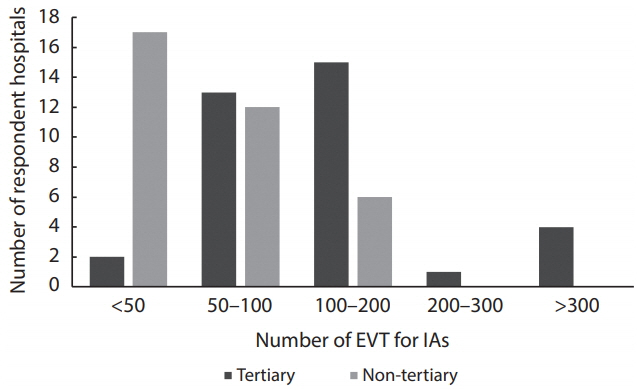Neurointervention.
2020 Mar;15(1):18-24. 10.5469/neuroint.2019.00157.
Endovascular Treatment for Intracranial Aneurysms: A Nationwide Survey in Korea
- Affiliations
-
- 1Department of Neurosurgery, Ewha Womans University Seoul Hospital, Ewha Womans University College of Medicine, Seoul, Korea
- 2Department of Neurosurgery, International St. Mary’s Hospital, Catholic Kwandong University College of Medicine, Incheon, Korea
- 3Department of Radiology, Ajou University Hospital, Ajou University College of Medicine, Suwon, Korea
- 4Department of Radiology, Gangnam Severance Hospital, Yonsei University College of Medicine, Seoul, Korea
- KMID: 2502078
- DOI: http://doi.org/10.5469/neuroint.2019.00157
Abstract
- Purpose
In Korea, endovascular treatment (EVT) for intracranial aneurysms (IAs) has increased steadily. We conducted a nationwide survey to evaluate the current status of EVT for IAs and to identify treatment preference in the real world.
Materials and Methods
A Google online survey was distributed to representative clinicians at hospitals treating IAs, where members of Korean Society of Interventional Neuroradiology (KSIN). The data was collected from October 2017 to December 2017. The responding hospitals were divided into 2 groups (tertiary and non-tertiary hospitals). And variable factors involved in decision making for treatment were evaluated.
Results
In total, 73 hospitals (tertiary: 37, non-tertiary: 36) responded to the survey. Most hospitals that responded had over 100 cases of diagnostic angiography (93%) and over 50 cases of EVT for IAs (74%) performed in 2016. The proportion of EVT for ruptured aneurysms in non-tertiary hospitals was significantly higher than tertiary hospitals (49% vs. 9%). The proportion of EVT for unruptured aneurysms at non-tertiary hospitals was significantly higher than tertiary hospitals (66% vs. 44%). Most physicians tended to make decision for treatment on location, shape, and size of unruptured IAs and patients’ age, more than the results from previous clinical trials for unruptured IAs. Although EVT was preferred for older patients (age >70) with unruptured IAs (99%), surgical clipping was still considered as the first treatment of choice for younger patients (age 30 to 50 years) at considerable rates (56%). Over two-thirds of respondents preferred surgical clipping for middle cerebral artery aneurysms, while EVT was preferred initially at other locations.
Conclusion
This nationwide survey showed that EVT is considered as the first treatment modality for IAs and there is a discrepancy between current guidelines and real-world practice for decision making of treatment options.
Figure
Cited by 2 articles
-
National Trends in the Treatment of Ruptured Cerebral Aneurysms in Korea Using an Age-adjusted Method
Hye Ran Park, Jae Heon Kim, Suyeon Park, Jae-Chil Chang, Sukh Que Park
J Korean Med Sci. 2020;35(39):e323. doi: 10.3346/jkms.2020.35.e323.Microcatheter Stabilization Technique Using Partially Inflated Balloon for Coil Embolization of Paraclinoid Aneurysms
Yunsun Song, Boseong Kwon, Abdulrahman Hamad Al-abdulwahhab, Ricky Gusanto Kurniawan, Dae Chul Suh
Neurointervention. 2021;16(2):132-140. doi: 10.5469/neuroint.2021.00185.
Reference
-
1. Suh SH. The annual trends between neurointerventional and neurosurgical procedures in Korea: analysis using HIRA data from 2010 to 2016. Neurointervention. 2017; 12:77–82.
Article2. Lee WK, Oh CW, Lee H, Lee KS, Park H. Factors influencing the incidence and treatment of intracranial aneurysm and subarachnoid hemorrhage: time trends and socioeconomic disparities under an universal healthcare system. J Neurointerv Surg. 2019; 11:159–165.
Article3. Lee YM, Hwang SM, Kim EH, Lee DG, Shim JH, Suh DC. Current status of neurointerventional activities in Korea. Neurointervention. 2013; 8:65–67.
Article4. Ryu CW, Hwang SK, Jung HD, Park YS, Park MH, Kim HJ. The present status of neurointerventional angiographic systems and workers in Korea. Neurointervention. 2009; 4:116–124.5. Kim JE, Lim DJ, Hong CK, Joo SP, Yoon SM, Kim BT. Treatment of unruptured intracranial aneurysms in South Korea in 2006 : a nationwide multicenter survey from the korean society of cerebrovascular surgery. J Korean Neurosurg Soc. 2010; 47:112–118.
Article6. International Study of Unruptured Intracranial Aneurysms Investigators. Unruptured intracranial aneurysms--risk of rupture and risks of surgical intervention. N Engl J Med. 1998; 339:1725–1733.7. UCAS Japan Investigators, Morita A, Kirino T, Hashi K, Aoki N, Fukuhara S, et al. The natural course of unruptured cerebral aneurysms in a Japanese cohort. N Engl J Med. 2012; 366:2474–2482.
Article8. Greving JP, Wermer MJ, Brown RD Jr, Morita A, Juvela S, Yonekura M, et al. Development of the PHASES score for prediction of risk of rupture of intracranial aneurysms: a pooled analysis of six prospective cohort studies. Lancet Neurol. 2014; 13:59–66.
Article9. Molyneux A, Kerr R, Stratton I, Sandercock P, Clarke M, Shrimpton J, et al. International Subarachnoid Aneurysm Trial (ISAT) of neurosurgical clipping versus endovascular coiling in 2143 patients with ruptured intracranial aneurysms: a randomised trial. Lancet. 2002; 360:1267–1274.
Article10. Fargen KM, Soriano-Baron HE, Rushing JT, Mack W, Mocco J, Albuquerque F, et al. A survey of intracranial aneurysm treatment practices among United States physicians. J Neurointerv Surg. 2018; 10:44–49.
Article11. Jeong HW, Seo JH, Kim ST, Jung CK, Suh SI. Clinical practice guideline for the management of intracranial aneurysms. Neurointervention. 2014; 9:63–71.
Article12. Seo DH, Kang HS, Kim DW, Park SQ, Song Y, Sheen SH, et al. Guidelines for the management of unruptured intracranial aneurysm. Korean J Cerebrovasc Surg. 2011; 13:279–290.13. Bender MT, Wendt H, Monarch T, Beaty N, Lin LM, Huang J, et al. Small aneurysms account for the majority and increasing percentage of aneurysmal subarachnoid hemorrhage: a 25-year, single institution study. Neurosurgery. 2018; 83:692–699.
Article14. Sonobe M, Yamazaki T, Yonekura M, Kikuchi H. Small unruptured intracranial aneurysm verification study: SUAVe study, Japan. Stroke. 2010; 41:1969–1977.
- Full Text Links
- Actions
-
Cited
- CITED
-
- Close
- Share
- Similar articles
-
- Endovascular treatment of intracranial aneurysms: Past and present
- Current Update on the Randomized Controlled Trials of Intracranial Aneurysms
- Comprehension of Two Modalities: Endovascular Coiling and Microsurgical Clipping in Treatment of Intracranial Aneurysms
- Surgical Management of Intracranial Aneurysms in the Endovascular Era : Review Article
- Guideline for Management of Unruptured Intracranial Aneurysms: Preliminary Report



